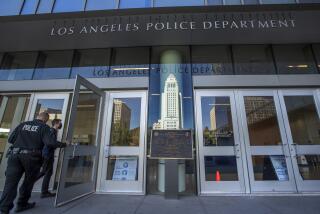Pasadena police implement changes a year after fatal officer-involved shooting
- Share via
This month, patrol officers in the Pasadena Police Department tried something new: They went door to door, introducing themselves, handing out business cards and saying hello.
Some residents greeted them with mouths hanging open, interim Chief Christopher Vicino said. Others wanted to know what the trouble was that brought the police to their door.
The 10-hour “community day,” in which officers sought to build relationships with the residents in neighborhoods they patrol across the city, was one of the new measures sparked in part by a watchdog report that reviewed a fatal police shooting of a man during a traffic stop one year ago. Going door-to-door was an idea proposed by the officers’ union, Vicino said. Next month, officers will start undergoing tactical training with “simunitions,” or fake ammunition, he said.
The report by the L.A. County Office of Independent Review questioned the tactical decision-making of the two officers who shot and killed 38-year-old Leroy Barnes Jr., and recommended a host of reforms in the way the department trains officers and investigates police shootings. The report also recommended that the department improve the way it communicates with the public after high-profile incidents.
“We have looked at ourselves really hard,” said Vicino, who is in the running to become permanent police chief. He said he also walked the streets with his officers this month. “It’s going to help us get better.”
Vicino, who took the helm in November, stressed that the February 2009 shooting death of Barnes, who police said was armed with a gun, was not the only reason behind changes at the department, but said it was a “partial catalyst.”
Barnes’ family said the changes were long overdue in northwest Pasadena, a neighborhood beset by violence and poverty that stands in stark contrast to the affluence of surrounding areas.
“It’s about time. It’s been a long time waiting for this to happen,” said Detrick Bright, the mother of Barnes’ 10-year-old daughter, Anari.
The two live a block away from the intersection where Barnes was killed. Bright said she sensed a more respectful approach from the police in her neighborhood during Barnes’ memorial last Friday, when members of his family lighted candles and put up balloons in the intersection.
“It’s a good thing. I just wish it would’ve been in place a year ago and he would still be here.”
Bright said she hoped the changes in the department would mean other families would not have to go through what she and her daughter did.
Barnes’ mother, Patricia Lee, said incidents like her son’s death could be prevented if police had a better relationship with the community before high-tension situations arise.
“I think they’re so . . . scared when they work over here,” said Lee, whom Barnes lived with in the months before the shooting. “Come into the community. Get to know people. Let them get to know you.”
Residents criticized the shooting because several of the shots were fired at Barnes’ back as he was lying facedown on the ground.
The department also initially said Barnes got out of the car and fired at the officers, then later said he never fired his gun and was shot during a struggle in the back seat of the car.
A lawsuit filed on behalf of two of Barnes’ children alleged wrongful death and constitutional violations by the police.
The officers’ names have been withheld by court order at the request of the police union and the two officers.
But according to law enforcement records reviewed by The Times, the officers who shot Barnes were Charles Reep, who fired seven shots, and Michael Alvarado, who fired four shots. Reep is a veteran officer with more than 10 years on the job who had been involved in three previous shootings, none of which resulted in injuries. Alvarado was hired in late 2007, according to information from the state Commission on Peace Officer Standards and Training.
Neither Reep nor Alvarado immediately returned requests for comment.
Lee said Barnes, who had a long rap sheet and had been in and out of prison for most of his adult life, was trying to turn his life around, earning his GED in 2007 and taking care of her.
She said she wanted a chance to meet the officers who shot her son, and ask them why they “handled it the way they did.”
“Let me tell them how big this hole is over here they made in my heart,” she said.
As for the changes at the Police Department, she said, “I’ll believe it when I see it.”
More to Read
Sign up for Essential California
The most important California stories and recommendations in your inbox every morning.
You may occasionally receive promotional content from the Los Angeles Times.











